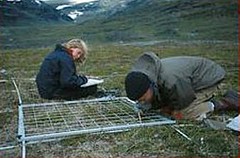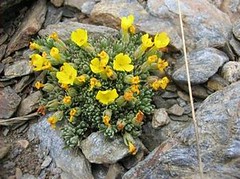 由於氣候暖化的影響,偏好寒冷環境的植物物種正逐漸從歐洲南部的山麓消失。 歐洲研究人員的兩份新調查顯示,許多物種由於分佈範圍狹小,正瀕臨滅絕。
由於氣候暖化的影響,偏好寒冷環境的植物物種正逐漸從歐洲南部的山麓消失。 歐洲研究人員的兩份新調查顯示,許多物種由於分佈範圍狹小,正瀕臨滅絕。
發表在《自然》和《科學》 期刊的研究是全球高山環境觀測計劃(Global Observation Research Initiative in Alpine Environments, GLORIA)的一部分。在今日,全球高山環境觀測計劃是一個範圍涵蓋世界所有高山地區的大型網絡,而全球高山環境觀測計劃歐洲本部的研究人員已觀察到了某些變化。
過去10年間,歐洲各地的研究人員收集了來自13個不同高山地區的樣本。
研究人員利用數位技術和密集的田野調查,以方格法觀察森林界線到山頂間不同海拔高度的植被相變化。
數位攝影提供了精細的圖片,顯示從2001年至今,某些物種已經消失。
如今,研究人員已觀察到物種開始往高海拔遷移,且根據10年來採集的樣本顯示,歐洲南部山區物種的多樣性正在降低。
西班牙格拉納達大學(University of Granada)參與全球高山環境觀測計劃研究的研究人員證實,氣候變遷是導致植物遷移到更高海拔的原因。該研究分析2001至2008年間,歐洲17個地區中66座高峰物種多樣性的變化。
 研究人員在伊比利半島庇里牛斯山(Pyrenees)歐德薩(Ordesa)及內華達山(Sierra Nevada)格拉納達的調察發現,所研究物種平均向上遷移2.7公尺。
研究人員在伊比利半島庇里牛斯山(Pyrenees)歐德薩(Ordesa)及內華達山(Sierra Nevada)格拉納達的調察發現,所研究物種平均向上遷移2.7公尺。
研究結果亦顯示,歐洲山區高峰上生長的物種數量在7年間已增加了平均數量的8%。
在寒帶和溫帶地區的66座山峰中,大多數之物種多樣性都有增加的現象。而在地中海地區,14座高峰之研究中有超過八個的物種數量在減少。
氣候與歐洲其他地區不同的地中海山脈,呈現出最明顯的物種多樣性變化。
一般來說,雖然高山地區的特有植物會受到氣候變遷影響,然需要高濕土壤的物種則更容易受影響。
格拉納達大學的研究顯示,物種多樣性在地中海低海拔地區的變化比其他地區更明顯。
在地中海山區如內華達、科西嘉島(Corsica)、亞平寧山脈(Apennines)中部和克里特島(Crete),溫度上升導致年降雨量的下降,進而造成夏季更長的乾旱。
由此可知,溫度上升和乾旱威脅著地球上所有的特有物種。
格拉納達大學的研究小組已與內華達全球觀測站(Observatorio de Cambio Global de Sierra Nevada)及摩洛哥(Morocco)的研究團隊合作,預計在亞特拉斯山(Atlas)西部設置觀測點,並在明年夏天安裝溫度計。
As the climate warms, plant species that prefer a colder environment are disappearing from the mountain ranges of Southern Europe. Since many of these species have small distribution areas, they are now threatened with extinction, according to two new studies from European researchers.
Published in the journals "Nature" and "Science," the studies are part of the broader Global Observation Research Initiative in Alpine Environments, or GLORIA. Today, GLORIA is a mega-network covering all the world's mountain regions, but it is GLORIA's original European arm that has reached a stage where researchers have started to observe changes.
Over a period of 10 years, researchers around Europe have gathered samples from 13 different mountain regions.
Using digital technology and intensive on-site field work, they have been able to study a grid pattern of square meters, selected on different high mountain summits, from the treeline up to the highest peaks.
The digital photographs provide a detailed picture of which species have disappeared between 2001 and the present day.
Today, the researchers are able to observe that species are migrating upwards and that the variety of species in Southern European mountain regions has declined during the 10 years in which samples have been taken.
In Spain, researchers at the University of Granada participating in the GLORIA study confirmed that climate change is causing plants to migrate to higher altitudes. This study analyzed species diversity shifts in 66 summits of 17 European ranges between 2001 and 2008.
On the Iberian Peninsula, two target regions were selected - Ordesa in the Pyrenees and Granada in the Sierra Nevada. Researchers found that the species under study had migrated an average of 2.7 meters (8.85 feet) upwards.
The study also reveals that the number of species growing on the summits of European mountains has increased an average of eight percent over the seven year study period.
Of the 66 peaks in boreal and temperate areas, the majority revealed an increase in species diversity. In the Mediterranean area, eight out of the 14 summits studied showed a decline in the number of species represented.
The mountains that present the most significant shifts in species diversity are Mediterranean mountains located in Southern Europe, where climate is different from that of the rest of Europe.
In general, moist-soil species are more vulnerable to climate change, though high-mountain endemic species are also affected.
The University of Granada research shows that species diversity has changed more at low elevation sites in the Mediterranean region than in other regions.
In the Mediterranean mountain ranges of Sierra Nevada, Corsica, Central Apennines and Crete, the rise in temperatures is causing a decline in annual average rainfall, which results in longer summer droughts.
As a result, temperature increases and droughts are threatening unique species found nowhere else on Earth.
The University of Granada research group has coordinated with the Observatorio de Cambio Global de Sierra Nevada, and has established, in collaboration with a research group from Morocco, another target region in the high Western Atlas, where observation plots and thermometers will be installed next summer.





